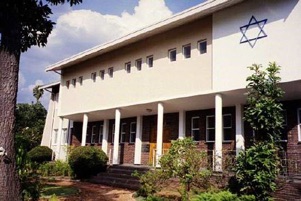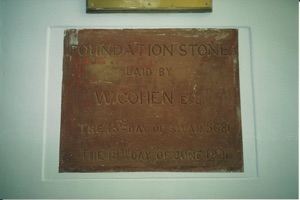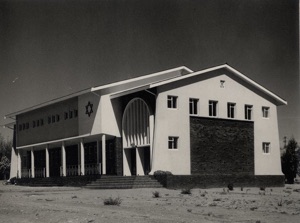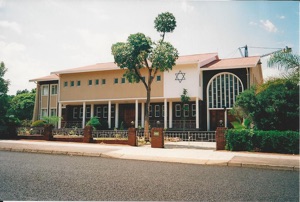Pietersburg, South Africa
Shul History in Summary
In 1912, Pietersburg founded its own congregation, the Pietersburg Hebrew Congregation. A Jewish burial society, a benevolent society and the Pietersburg-Zoutpansberg Zionist Society was formed. A communal hall was built in 1921 and a synagogue in 1953. Description Pietersburg Hebrew Congregation Milestones
1883 First record of Jews settling in the area of Pietersburg, South Africa
1893 First recorded communal Jewish prayer service in Pietersburg
1896 First recorded burial in the Pietersburg Jewish cemetery
1897 Establishment of the Pietersburg Hebrew Congregation incorporating the Pietersburg Jewish Burial and Benevolent Societies
1921 Consecration of the first Synagogue at 23 Jorissen Street, Pietersburg
1953 New Synagogue consecrated at 23 Jorissen Street, Pietersburg
Old Synagogue converted to the Rev Jacob Levine Communal Hall
1994 Rev Jacob Levine Communal Hall sold
1995 Opening of the Wally Levy Hall adjoining the Synagogue
2003 Synagogue and Wally Levy Hall closed and its contents relocated to Tel Mond, Israel
THE HISTORY OF THE PIETERSBURG [POLOKWANE] JEWISH CONGREGATION
The town of Pietersburg, named after Voortrekker kommandant-general Pieter Jacobus Joubert, was established in 1868. A document was signed in Renosterpoort whereby the farm Sterkloop was sold to the then government. Amongst the names on the document were those of L C Kauffman and A J Marcus, who were possibly Jewish. This was possibly the earliest written reference to Jews in the area.
The early Jewish settlers arrived in the period 1890 to 1900 from Lithuania, Russia and Latvia, drawn to the area by the discovery of gold at Eerstegoud which is situated about 20 kilometres from Pietersburg. However, the gold deposits were not that lucrative, therefore many of the Jews instead opened trading stores on tribal lands, as well as hotels. Land was also cheap and attracted newcomers. The single young men started trading posts in remote areas where they were often the only Whites. They sold staples such as maize meal and sugar to the black population and household goods and agricultural implements to the farmers, who travelled long distances to these stores. Some Jews established hotels as way stations for the smous and commercial traveler at the back of the isolated general dealer’s stores or in the small country villages. Once the men became established and their economic situations improved, they sent money back to their home countries, so that they could bring their families out to South Africa. Most Jews therefore came to the Pietersburg area because of business opportunities or because they already had family members living there who could give them assistance. Several villages grew around these stores such as Soekmekaar, which was started by the Kahan family.
The earliest Jewish settlers in the Northern Transvaal included Patsy Cohen, Barney Herman, Herman Hirschman, Wolff and Max Israelson, Ben Levy, Herman Eicholtz, Solly Marcus and Marcus Rosenburg. Jews were to be found in the areas around Pietersburg including Soekmekaar (where minyanim were held), Newsmitsdorp, Kalkbank, Houtbosdorp and Grootspelonken.
In 1895 Mr I Wilensky was the first Jew buried in the Pietersburg Jewish Cemetery. At about that time Paul Kruger, President of the Zuid Afrikaanse Republiek, visited Pietersburg. A delegation from the Jewish community, led by Patsy Cohen and Barney Herman (later chairman of the congregation for 35 years), approached President Kruger with a request for a burial ground explaining to him it was halakhic for Jews to have their own cemetery. Although the Christian cemetery at that time covered an area of four morgen, Kruger allocated only two morgen to the Jews. When Cohen asked why the Jewish cemetery could only be half the size of the Christian one, Kruger had no hesitation in explaining that as the Jews believed in only half the bible they were entitled to only half the land. However, after much protestation by Cohen, the President relented and gave the Jews their four morgen.
There were two main family clans in the district, namely the Hirschmann and Israelsohn/Eicholtz families. They grew in numbers as their patriarchs brought their family members out of Eastern Europe. There was no intermarriage between the two families until Reverend Levine’s daughter Sarah married George Eicholtz and then his second daughter Lily married Kuba Rakusin of the Hirschmann clan. By so doing she became the link between the families.
During the Anglo-Boer War 1899-1902 some of the Jews in the Pietersburg area, especially those of British descent, left for the Cape, where they saw out the War. However, the majority remained but maintained their neutrality. Jews from the Zoutpansberg region, who were naturalized before 1899, included Messrs Solomon Wolf Himmelhoch, Herman Hirschmann, Joseph Kallmeyer, ‘Makkie’ Israelsohn, Barnard Herman, Leon Miller and Marcus Rosenberg and they remained neutral during the War. The Jews attempts to claim compensation from the British after the War were mostly unsuccessful. The British used a loophole in the law in order to evade paying the Jews compensation. They were using the fact that the Jews from Russia could not produce proof of Russian citizenship to deny them any payment. Nevertheless, the Jews managed to rebuild their businesses after the War even without the compensation monies that their Boer neighbours received from the British.
The Zoutpansberg Hebrew Congregation, which included both the villages of Louis Trichardt and Pietersburg and the surrounding areas, was established around 1897. The first president of the Zoutpansberg Hebrew Congregation was Bernard Herman. In 1912 the Pietersburg community formed their own congregation known as the Pietersburg Hebrew Congregation [PHC], but Louis Trichardt retained the original name. As the Pietersburg community had no synagogue of their own, they held their services in the Masonic hall. Mr Kallmeyer was the chairman of the Zoutpansberg then the Pietersburg Hebrew Congregation from 1904 until 1916. Mr S Kaufman took over as chairman of the Pietersburg Hebrew Congregation from 1917 to 1918. After this, Mr Barney Herman was chairman for 34 years. Mr A Zaidel, with the assistance of Mr Marcus and Mr Manaschewitz, drew up the constitution of the Pietersburg Hebrew Congregation. It was adopted by members on 22 November 1925.
The first synagogue was built in 1921 at 23 Jorrison Street. The foundation stone was laid by one of the first Jews in the district, Mr W [Patsy] Cohen, at a ceremony held on 19 June 1921. The office bearers at the time were the chairman Barney Herman and the secretary Ben Levy. Rev M L Cohen was the appointed spiritual leader. At that time there were some 70 members of the congregation.
The community grew rapidly in the 1930s and 1940s and a larger synagogue was needed. The new synagogue was finally built in 1953. The foundation stone was laid by Mr Ben Levy on 14 September 1953. The old synagogue/hall was then converted into the Reverend Jacob Levine Communal Hall. Some years later a rabbi’s house was also built on the property.
The Pietersburg Hebrew Congregation [PHC] required their religious leader to be a cheder teacher and youth leader, a shochet, a chazan and preacher, and a representative of the Hebrew community in the Gentile world. Very few ministers were able to fulfill all these criteria effectively. In Pietersburg because only a few Jews observed the Sabbath or studied the Torah, the minister suffered spiritual isolation. Minyans were usually obtained at Friday evening and Festival services as many members had a strong sense of Jewish identity and considered the synagogue to be a meeting place where they could meet other Jews. The religious leaders and congregation chairmen were always exhorting the men to attend synagogue services, especially on Sabbath mornings, as many businessmen started to keep their businesses open on Saturdays. Despite the kosher meat problems and the distances from centres where kosher products could be bought, a large percentage of Jews bought kosher meat. Despite their laxity in observance, most Jews therefore centred their Jewish identity in the synagogue and only a small number considered their participation in Zionist organizations as their only Jewish identity.
The most notable spiritual leader was Rev Jacob I Levine who served the community faithfully from 1931 until his death some 30 years later. He was highly respected by both the Jewish and non Jewish communities in the area.
On 24 May 1931 the Pietersburg Jewish Burial Society was incorporated into the Congregation and a Benevolent Society was formed. Wally Levy was chairman of the Chevrah Kadisha for 40 years. The Wally Levy Hall built in 1994 adjacent to the synagogue was named in his honour. There are some 250 graves in the Pietersburg cemetery.
The Pietersburg-Zoutpansberg Society was established in 1912 and the Pietersburg Womens Zionist League in 1932. The Jews of the Northern Transvaal were strong supporters of Zionism and in the 1980s were amongst the largest contributors per capita to Israel in the world. After more than twenty years of trying, women were only granted the franchise by the Pietersburg Hebrew Congregation synagogue committee for the first time in 1947. The Pietersburg Women’s Guild was established on 2 October 1947. A chapter of the Hebrew Order of David was established in 1952. Bar and Bat Mitzvahs, weddings and other functions were regularly conducted. There were a large number of Jewish children who took Hebrew lessons. The congregation also served Jews in the surrounding district and towns such as Potgietersrus, Louis Trichardt, Messina and Tzaneen.
Jews played major roles in business, the professions, industry, agriculture and on the sports fields in the area, and made invaluable contributions in their fields. They were also active in charity and civic affairs, three of them became mayors of the town, namely Barney Herman, Max Marcus and Moss Cohen.
The number of Jews began to decline from the late 1950s. The youth moved to the larger cities where there were better economic opportunities and their parents soon followed.
In 1991 it was decided that the services of a full time spiritual leader were no longer viable or affordable. At this time the congregation consisted only of some 22 members. Regular minyanim and Chagim were still held and functions were catered for by the Women’s Guild.
In January 1994, the treasurer, Mr Dennis Wiener, suggested that a sub-committee should be formed to decide on the future of the congregation because of its poor financial situation and the declining number of members. As the community was dwindling, in February 1994 the communal hall and house were sold to the Moolman Group who undertook to build a new communal hall for the community, attached to the synagogue. The new hall was officially opened on 5 March 1995 by Chief Rabbi Cyril Harris.
After being approached by Shivtei Yisrael shul in Ra’anana, a synagogue built by South African expatriates in 1999, it was decided to donate two Sifrei Torah to them. The occasion was celebrated at a Hachnasat Sefer Torah held at Shivtei Yisrael on 20 May 2001, Yom Yerushalayim 5761. This event was attended by a delegation from the Pietersburg Hebrew Congregation, ex-members living in Israel, Rabbi Silberhaft, the rabbi to the South African country communities, the chief rabbi of Ra’anana, the mayor and deputy mayor of Ra’anana and many other dignitaries.
In November 2001, as the community could no longer make up minyans on Friday nights, it was suggested that the synagogue be sold to the Moolman Group. As a result of an agreement with Mr Darryn Platzky, the contents of the Pietersburg synagogue were to be installed in the new synagogue that was to be built in Tel Mond, Israel. The plaques and memorabilia from the Pietersburg synagogue were to be displayed on a wall especially made for this purpose. This would ensure that the memory of the Pietersburg synagogue would be perpetuated for posterity.
A de-consecration service for the Pietersburg synagogue was held by Rabbi Silberhaft on Friday evening 31 January 2003. The contents of the synagogue’s kitchen were handed over to the Selwyn Segal Hostel in Johannesburg. The synagogue was closed and its contents were shipped to Israel. The library was transferred to the SAJBD Library.
The Mevasser Synagogue in Tel Mond was opened on 25 June 2013 with the original benches, bimah, clock etc from the Pietersburg synagogue. The ceremony was attended by many ex-Pietersburgers who were deeply moved by the continuation of their shul's legacy.


These photos are the property of Charlotte Wiener and can only be used with her written permission
Synagogues and other Jewish Buildings






